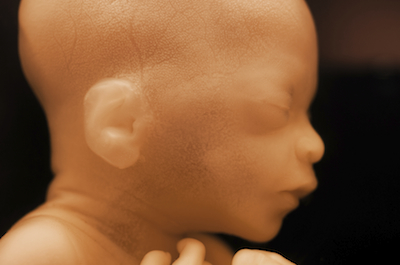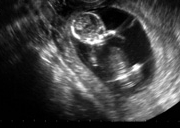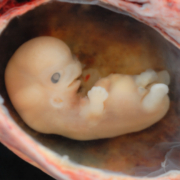You wouldn’t do it to a dog! Current fetal pain relief in NHS abortions
 This blog should perhaps carry one of those BBC-style warnings, ‘some viewers may find the following content distressing’. This is because it deals with something most of us would prefer not to think about – the dispatching of an unwanted, late-second or third-trimester fetus, or ‘feticide.’ We do not here comment on the morality of abortion but on the practice of late-term abortion in light of current evidence regarding fetal pain awareness.
This blog should perhaps carry one of those BBC-style warnings, ‘some viewers may find the following content distressing’. This is because it deals with something most of us would prefer not to think about – the dispatching of an unwanted, late-second or third-trimester fetus, or ‘feticide.’ We do not here comment on the morality of abortion but on the practice of late-term abortion in light of current evidence regarding fetal pain awareness.
Such abortion procedures are subject to guidelines produced by the Royal College of Obstetricians and Gynaecologists (RCOG). In December 2022, the RCOG published their long-awaited ‘Fetal Awareness Evidence Review’, an update of ‘RCOG Fetal Awareness 2010’. Gone from the latest document is the earlier assertion that ‘the fetus is in an unconscious state until birth’. Gone, too, is the ill-founded reassurance for parents that ‘the fetus does not experience pain’. These updates are to be welcomed.
However, the RCOG continues to assert that the cortex and intact thalamocortical tracts are necessary for pain experience and that, therefore, fetal pain perception is not possible before 28 weeks gestation.
More recent evidence calls this assertion into question. Dr Stuart Derbyshire was part of the RCOG working group that, in 2010, argued it was unnecessary to provide analgesia in the case of abortion during any stage of pregnancy. But in a 2020 article, ‘Reconsidering Fetal Pain’,[i] he argues that the latest developments in neuroscience suggest there is the potential for ‘an immediate and unreflective pain experience mediated by the developing function of the nervous system from as early as 12 weeks’. His co-author, JC Bockmann, summarises their findings, stating that ‘Fetal analgesia and anaesthesia should thus be standard for abortions in the second trimester, especially after 18 weeks…’.
Other evidence that the 20-week unborn fetus can experience pain includes:
- the unborn child reacts to stimuli that would be recognised as painful if applied to an adult human, for example, by withdrawal or recoiling [ii]
- extremely premature babies born at 20 weeks are clearly able to experience pain
- anencephalic infants, whose cortex is severely reduced, if not altogether missing, may experience pain [iii]
- in adults, stimulation or ablation of the cerebral cortex does not alter pain perception, while stimulation or ablation of the thalamus does [iv]
- the structures used for pain processing in early development are unique and different from those of adults, and many of these fetal structures and mechanisms are not maintained beyond specific periods of early development [v]
- four-dimensional ultrasound evidence of a 23-week fetus receiving anaesthetic puncture clearly shows them crying in response.
The RCOG’s stance would seem to be out of step with the growing weight of evidence that the fetus can experience pain, possibly as early as twelve to fourteen weeks, but certainly by 18-20 weeks. This seems to be via mechanisms not dependent on a functioning cortex, spinothalamic, or thalamocortical connections.
Their position is also inconsistent with the experience of fetal surgeons who have found it necessary in practice to sedate the fetus with anaesthesia and pain relief from 16 weeks, to prevent the unborn child from moving about in reaction to invasive surgery.[vi] In 2019, NHS England recommended that pain relief be given to unborn babies undergoing surgery for spina bifida from 19 weeks gestation. How is it, then, that feticide, by the ‘Dilation & Evacuation’ method – a ‘dismemberment abortion’ without analgesia or anaesthetic – at the same stage of gestation, can be considered humane?
The RCOG’s 2022 update on fetal awareness painted a mixed picture of fetal analgesia during feticide. A recent Freedom of Information (FOI) survey of every NHS Trust providing maternity services in England reveals that 76 per cent of respondents (28 NHS Trusts) give/are willing to give direct fetal analgesia or sedation during a late-term abortion. This represents a significant response to campaigning since the issue was first raised as a concern in the 1980s. However, of the Trusts that provide fetal analgesia in these situations, only two-thirds (18 Trusts) do so as a standard procedure. In the remaining ten Trusts, they do so only if requested by the mother (always assuming the mothers know to ask for it). Fourteen per cent of respondents (five NHS Trusts) do not give direct fetal painkillers or sedatives and would not say if they would consider fetal painkillers if requested by the mother.
The most commonly used method to end the fetus’ life prior to dilatation and evacuation is the instillation of intracardiac potassium chloride (KCl). This is extremely painful if administered without proper anaesthesia. Cardiac puncture is itself painful, but the spasms induced by the KCl in the absence of sufficiently deep anaesthesia would be more so. According to the FoI survey, some trusts give a painkilling injection prior to administering KCl, such as fentanyl, morphine, or diazepam, whereas others give a potentially lethal dose of lidocaine or lignocaine. Others inject KCl into the umbilical cord; here, the injection site itself would be painless, but the pain induced in the body as KCl is carried in the bloodstream to the heart is extreme. Not for nothing is the inadvertent giving of a strong solution of KCl to an adult patient an NHS ‘Never Event’.
But one in seven NHS trusts (14 per cent) never administer fetal analgesia in late-term abortions. In the absence of clear guidance from RCOG that unborn babies receiving KCl should be anaesthetised as a matter of routine, it is likely that some will perish in appalling agony.
Could it be that the RCOG’s reluctance to issue clear directions owes something to the ideological resistance of abortion providers desperate to avoid any move that might risk ‘humanising’ the fetus?
The 2020 APPG inquiry noted, ‘It is strange but true that in these situations, a dog fetus at seven weeks gestation will have more protections in law than a human fetus [at an equivalent stage]. How odd that we should go to great lengths to define in law what constitutes a ‘humane’ way of killing a dog or a rabbit in the womb but not bother to provide comparable legislation to guarantee human fetuses a humane death.’
If you wouldn’t do it to a dog, why do we permit it in humans?
References
[i] Derbyshire S, Bockmann J. J Med Ethics. 2020;46:3–6
[ii] Gupta R, et. al. Fetal surgery and anaesthetic implications. Continuing Education in Anaesthesia, Critical Care & Pain. 2008; 8(2):71-75.
[iii] Brusseau R. Developmental Perspectives: is the Fetus Conscious? International Anesthesiology Clinics. 2008;46:3:17.
[iv] Ibid:16
[v]Anand K. Fetal Pain? Pain: Clinical Updates. 2006;14:2:3
[vi] Van de Velde M et al. Remifentanil for Fetal Immobilization and Maternal Sedation During Fetoscopic Surgery: A Randomized, Double-Blind Comparison with Diazepam. Anesthesia & Analgesia. 2005;101:256












Leave a Reply
Want to join the discussion?Feel free to contribute!